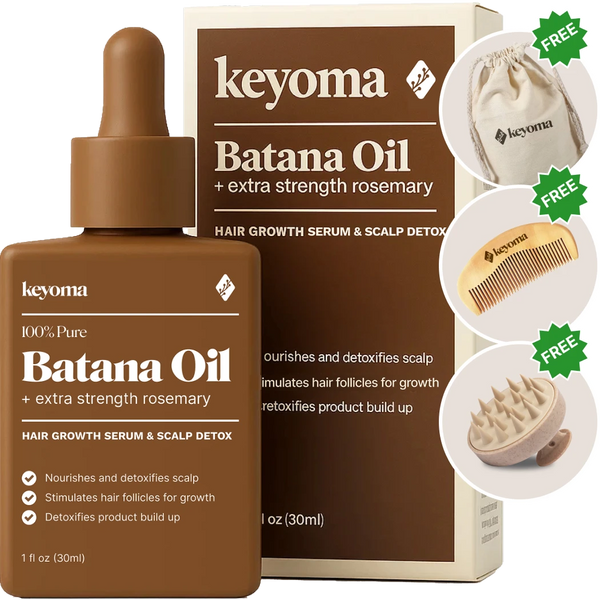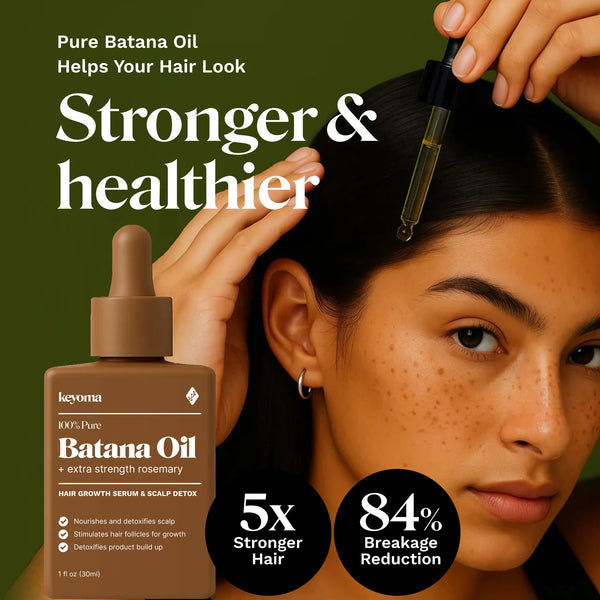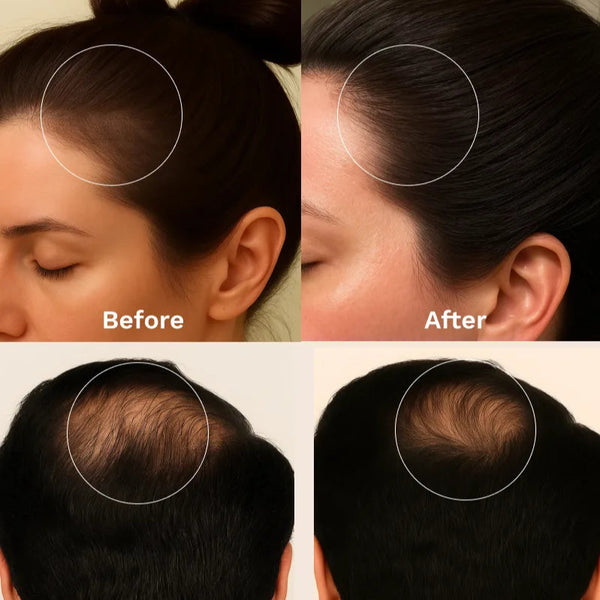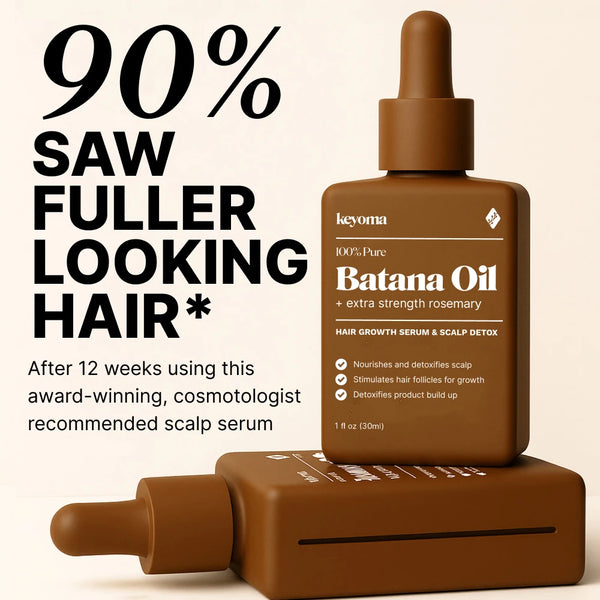In this article
Dry skin is annoying, and so is dandruff, but scalp psoriasis can bring a different set of challenges.
Psoriasis is an autoimmune condition that makes skin cells grow faster than normal. When inflammation rises, the cells stack up, forming red or silvery itchy plaques on your skin.
If you have psoriasis, you may notice signs in your nails, on your knees or elbows, and in other areas of your body. About 50% of people with psoriasis also see symptoms on the scalp.
Keep reading to learn how to tell scalp psoriasis from dandruff, calm flares, and protect your hair with gentle, practical steps.
Key Takeaways
-
Scalp psoriasis is an autoimmune condition that speeds up skin cell growth, causing itchy, scaly plaques that may weaken hair follicles.
-
Hair loss from psoriasis is usually temporary, triggered by inflammation and scratching, and often improves once symptoms are treated.
-
Triggers include stress, smoking, alcohol, illness, certain medications, and weather changes, making prevention part of care.
-
Gentle washing, medicated shampoos, conditioners, avoiding scratching, and managing triggers can reduce flares and limit hair loss.
Scalp Psoriasis Symptoms
Mild scalp psoriasis may show only light, fine scaling. Moderate to severe scalp psoriasis can include:
-
Red or purple bumpy patches
-
Silvery-white or gray scales
-
Dandruff-like flaking
-
Dry scalp
-
Itching
-
Burning
-
Soreness
-
Hair loss
If you notice these symptoms, see your doctor or a dermatologist. They may examine your scalp or do a small skin biopsy to rule out similar conditions like seborrheic dermatitis.
Main Types of Psoriasis
Plaque psoriasis is the most common form and the one that often shows up on the scalp. It causes raised red patches and silvery white scales on the skin. Besides the scalp, you may also see it on your elbows and knees.
Other psoriasis types include
-
Guttate psoriasis, which often shows up on your torso or trunk as well as the arms and legs.
-
Pustular psoriasis, commonly seen on your hands and feet.
-
Inverse psoriasis, usually found in skin folds under the breast, in the armpit, or in the groin.
-
Erythrodermic psoriasis, a rare but serious type that affects most of the body.
Scalp Psoriasis vs. Dandruff: How to Tell Them Apart

Dandruff is a common scalp condition. You will see tiny dry flakes on your scalp, and your scalp may itch.
Dandruff may show up when skin is oily, irritated, or dry. It can also happen when hair care products bother your scalp. Other health issues, including psoriasis and eczema, may cause it too.
Psoriasis also brings flaking and itching like dandruff, but you will notice other signs such as red or purple bumpy patches, soreness, and burning. Psoriasis occurs when your immune system attacks your skin cells, and unlike dandruff, it does not have a simple trigger.
Scalp Psoriasis vs. Seborrheic Dermatitis: How They Differ

Like scalp psoriasis, seborrheic dermatitis is a common scalp condition. It causes scaly, crusty patches, flakes, and itching on your scalp. Unlike scalp psoriasis, you will not see symptoms beyond your hairline. It is also easier to treat.
Psoriasis, by contrast, tends to cause thicker, drier patches. You might see these not only on your scalp but also on your elbows, knees, or lower back.
No one knows what causes seborrheic dermatitis, but dermatologists think it is linked to a type of yeast on the skin and to the oil your skin makes. Psoriasis relates to the immune system working in an unusual way.
Scalp Psoriasis Causes and Triggers
The cause of psoriasis is not fully known. Plaques form when an overactive immune system speeds up skin cell growth. Normal skin cells grow and shed in about a month. With psoriasis, this happens in three or four days, so cells build up on the surface instead of shedding.
Inflammation from psoriasis can affect other organs and tissues. People with psoriasis may also have related health conditions. About one in three people with psoriasis develop psoriatic arthritis. Scalp psoriasis can signal PsA because many people have both. If you think you have scalp psoriasis, see a dermatologist for diagnosis and a rheumatologist for a PsA screening.
Scalp psoriasis can be triggered by the same factors as other types of psoriasis. Common psoriasis triggers include:
-
Stress
-
Certain medications
-
Smoking tobacco
-
Alcohol
-
Injuries or trauma to the skin
-
Illness, such as infections
-
Changes in weather
-
Diet
How Psoriasis Can Cause Hair Loss
Can psoriasis lead to hair loss? Yes. When inflammation ramps up, hair follicles can weaken and become brittle. Combined with an itchy, dry scalp, you may feel tempted to scratch or pick at psoriasis scales.
When you do that, you can make your scalp psoriasis worse. As you try to relieve your symptoms with scratching, you could actually be causing some hair loss.
Inflammation alone can make hair shed, and extra irritation can speed the process along.
Can Psoriasis-Related Hair Loss Be Permanent?
Hair loss from psoriasis is usually not permanent. Hair often starts to return once the psoriasis symptoms driving hair loss calm down or clear. Still, healing takes time, and regrowth can be slow.
Hair can fall out when you scratch the itchy areas of the scalp caused by psoriasis. Scratching adds irritation and can lead to more shedding.
Treatment helps. Topical creams can ease itching and cut down scratching, and medications taken by mouth can reduce scales and inflamed skin.
9 Practical Ways to Prevent Hair Loss From Psoriasis
Psoriasis hair loss happens when hair follicles weaken and turn brittle because of increased inflammation on your scalp. Combine that with itching and scratching at scales, and thinning or sparse hair can follow. You can take steps to limit the fallout.

Use Natural Hair Oils
Natural plant oils can cushion your strands and seal in moisture, which helps cut down friction and breakage when your scalp is flaring. Warm 2 to 3 drops of Keyoma batana oil or a lightweight option like jojoba or argan between your palms, then smooth from mid-lengths to ends on damp hair.
Use Prescription Medicated Shampoos
Specialty prescription shampoos with clobetasol propionate may help reduce scalp plaques at the source. These shampoos are generally safe to use daily for up to 4 weeks, but ask your doctor about timing and whether to alternate shampoos to avoid drying your hair.
Do Not Skip Conditioner
Because medicated shampoo can strip natural oils, keep conditioner in your routine. It boosts scalp moisture and can mask the medicinal scent of prescription shampoo.
Wash With Finger Pads Only
Scratching at scalp scales raises your risk for breakage and loss. Since you need to rub your scalp to wash your hair, trim your nails and build lather with only the pads of your fingers.
Handle Hair With Care
Hair around areas of psoriasis needs a gentle touch. When brushing, keep soft strokes on the strands and avoid hitting the scalp with bristles. If you towel-dry, scrunch the ends instead of rubbing all over your head.
Patch-Test New Products
Before you try any new hair product, do a small test to check for a reaction. Dab a tiny amount on a patch of your scalp and cover it with a hat or headband. If nothing changes after 48 hours, it is likely OK to use.
Air Dry, Don’t Blow-dry
A psoriasis-covered scalp is already dry without added forced air, and medicated shampoo can dry it further. Skip the blow dryer, or use cool air if you must. Microfiber cloths and air drying help keep scalp moisture while your hair dries.
Identify and Avoid Triggers
Notice what makes your plaques worse and work to reduce those triggers. Drinking, smoking, high-stress environments, allergies, dry weather, and illness are common culprits.
Protect Your Scalp From the Sun
Sun exposure is tricky, since the right amount can help reduce plaques while too much can be harmful. Sunburns increase inflammation and dry out skin, so wear a hat outdoors.
Reduce Flares, Ease Itch, Protect Hair With Keyoma
Scalp psoriasis is a common skin condition that can bring frustrating symptoms like itching and soreness. It can also change how your scalp and hair look. With the right care and a steady routine, you can calm flares and keep your strands supported. For daily hair care, finish your wash routine with a few drops of Keyoma batana oil to soften ends and help seal in moisture.
Featured Product
100% Pure Batana Oil + Rosemary
↓Best Batana Oil to Buy↓
1 Month
Subscribe & Save
- 30-day supply delivered monthly $35
- 30% off for life $6
- Free haircare essentials kit $33
- Free custom wooden comb $10
- Free scalp massager $15
- Free eco-friendly travel bag $8
- 30-Day Money Back Guarantee
- Free Shipping
- Online portal for easy cancel, skip, or pause.
1 Month One Time Purchase
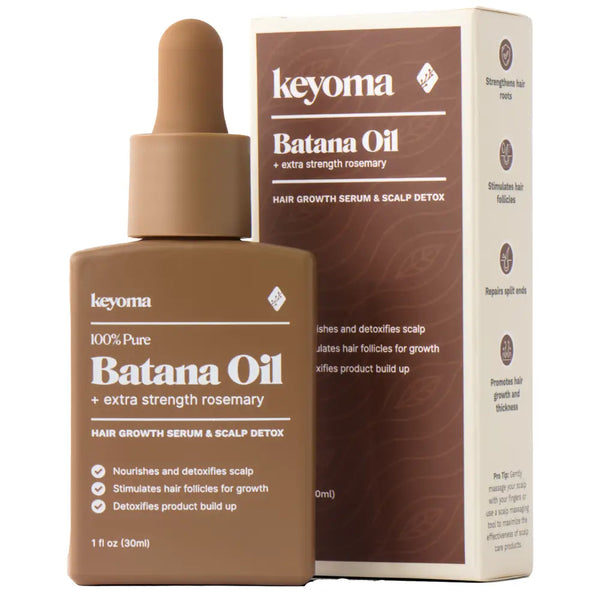
- 30-day supply $50
- 30% off for life $6
- Free haircare essentials kit $33
- Free custom wooden comb $10
- Free scalp massager $15
- Free eco-friendly travel bag $8



